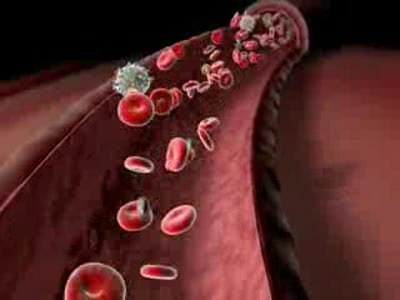But what we have is, the heart pumps de-oxygenated blood from the right ventricle.
那么我們看到,心臟把缺氧血從右心室排出
You're saying, hey, why is it the right ventricle?
大家可能要問,為什么是從右心室出來呢?
That looks like the left side of the drawing,
這不是在圖的左邊嗎?
but it's this dude's right-hand side, right?
但是,對于圖中的人來說,這卻是他的右邊
This is this guy's right hand.
這邊是這個人的右手邊
And this is this dude's left hand.
這是左手邊
He's looking at us, right?
因為跟我們是面對面的,所以方向剛好相反
We don't care about our right or left.
要考慮的不是我們的左右手邊
We care about this guy's right and left.
而是要以這個人的左右為準
And he's looking at us.
因為是面對面
He's got some eyeballs and he's looking at us.
這里是他的眼睛,我們是面對面的

So this is his right ventricle.
這是右心室
Actually, let me just start off with the whole cycle.
我們來看一下整個循環
So we have de-oxygenated blood coming from the rest of the body,right?
缺氧血從身體各處運送而來
This is de-oxygenated blood coming from the rest of the body right here
這是從身體各處運送而來缺氧血
This is actually the name for this big pipe. It's called the inferior vena cava--inferior because it's coming up below.
這條大血管的名字是下腔靜脈,之所以叫下腔靜脈,是因為它是在下部
Actually, you have blood coming up from the arms and the head up here.
血液從胳膊,頭部等各處而來
They're both meeting right here, in the right atrium.
來到右心房
Let me label that.
我標一下
I'm going to do a big diagram of the heart in a second. So it's the right atrium.
等會我們要單獨看一下心臟的圖示,這里是右心房
And why are they de-oxygenated?
為什么說這里是缺氧血呢?
Because this is blood returning from our legs if we're running, or returning from our brain,
因為這可能是從腿部回來的血,或者說從頭部回來的血
which needed- that had to use respiration--
這些經過呼吸作用
or maybe we're working out and it's returning from our biceps, but it's de-oxygenated blood.
比方說我們在健身,腿部或者二頭肌產生一定的消耗,這里是缺氧血
It shows up right here in the right atrium.
匯入右心房
It's on our left, but this guy's right-hand side.
這是我們的左手邊,但對這個人來說是右手邊
From the right atrium, it gets pumped into the right ventricle.
血液從右心房壓入右心室
It actually passively flows into the right ventricle.
血液其實是被動流入心室的
The ventricles do all the pumping, then the ventricle contracts and pumps this blood right here
至于心臟對血液的排擠輸送,都在心室中完成,心室收縮,把血液擠壓出去
and you don't see it, but it's going behind this part right here.
大家可能看不到,這部分在后邊
It goes from here through this pipe.
從這條血管出去
So you don't see it.
大家可能看不到
I'm going to do a detailed diagram in a second-- into the pulmonary artery.
我馬上畫一個更詳細的表格,流入肺動脈
We're going away from the heart.
血液遠離心臟
This was a vein, right?
這是一條靜脈
This is a vein going to the heart.
這里是流向心臟的
This is a vein, inferior vena cava vein.
這是下腔靜脈
This is superior vena cava.
這是上腔靜脈
These are veins. They're de-oxygenated.
這些都是靜脈,運送缺氧血
Then I'm pumping this de-oxygenated blood away from the heart to the lungs.
然后在心室把血液擠壓入肺部
Now this de-oxygenated blood, this is in an artery, right?
現在缺氧血是在動脈中
This is an pulmonary artery.
這里是肺動脈
Then it gets oxygenated and now it's a pulmonary vein.
然后氧氣得到補充,進入肺靜脈
And once it's oxygenated, it shows up here in the left-- let me do a better color than that--
血液變成含氧血之后,我畫的清楚一些
it shows up right here in the left atrium.
血液流入左心房
Atrium, you can imagine-- it's kind of a room with a skylight
大家可以把左心房看成是
or that's open to the outside and in both of these cases, things are entering from above--
上方開口的一個房間,兩個心房都是從上方流入血液
not sunlight, but blood is entering from above.
說是像陽光一樣傾瀉可能不太恰當
On the right atrium, the blood is entering from above.
在右心房,血液從上方流入
And in the left atrium, the blood is entering-- and remember,
左心房里,注意
the left atrium is on the right-hand side from our point of view--
在我們看來,左心房是在右邊
on the left atrium, the blood is entering from above from the lungs, from the pulmonary veins.
左心房中,血液是從上方的肺部通過肺靜脈流入
Veins go to the heart.
靜脈血流向心臟











